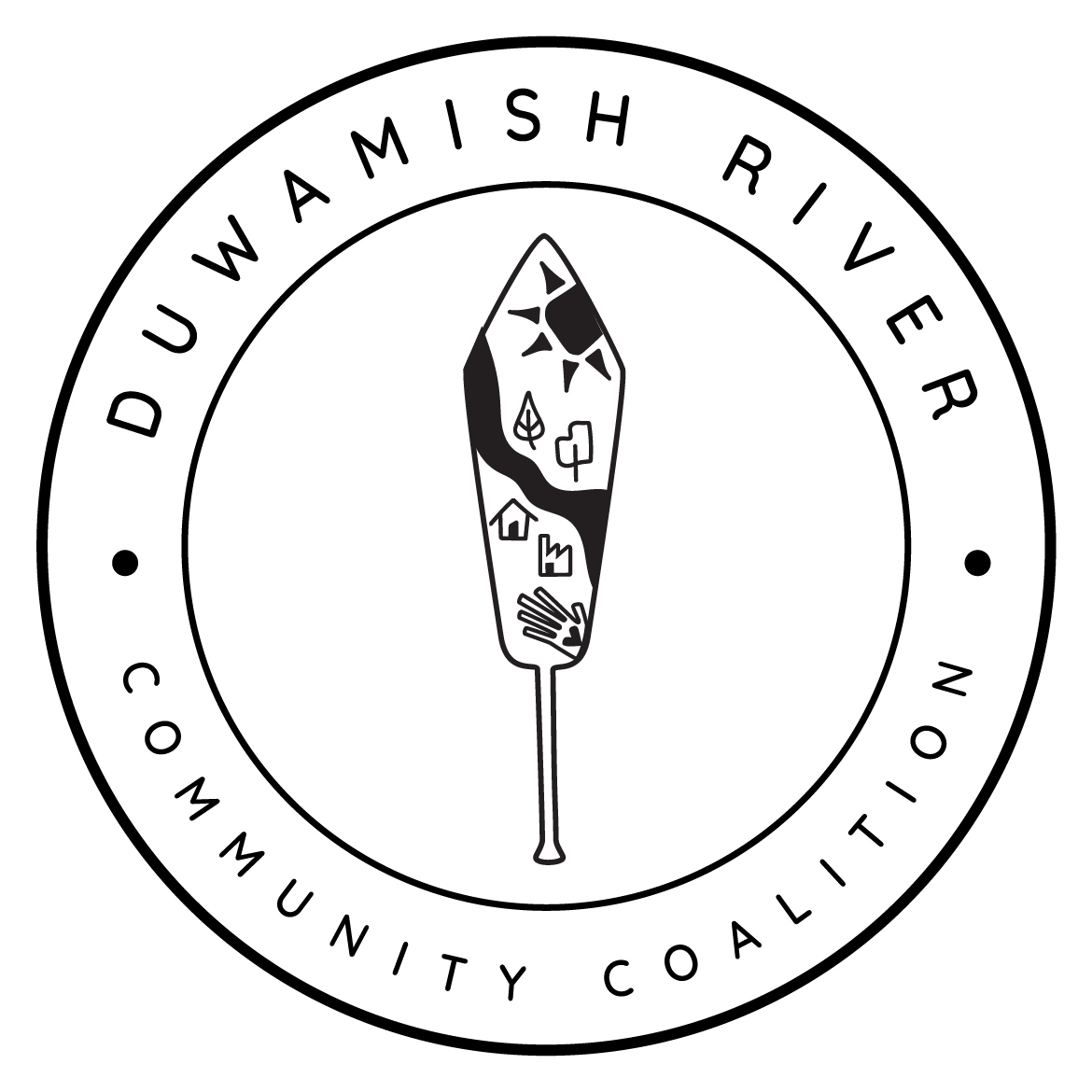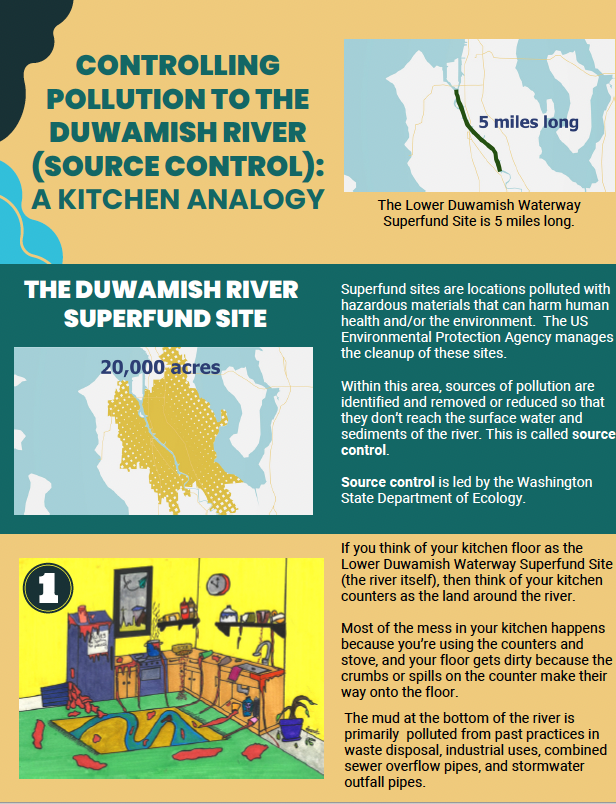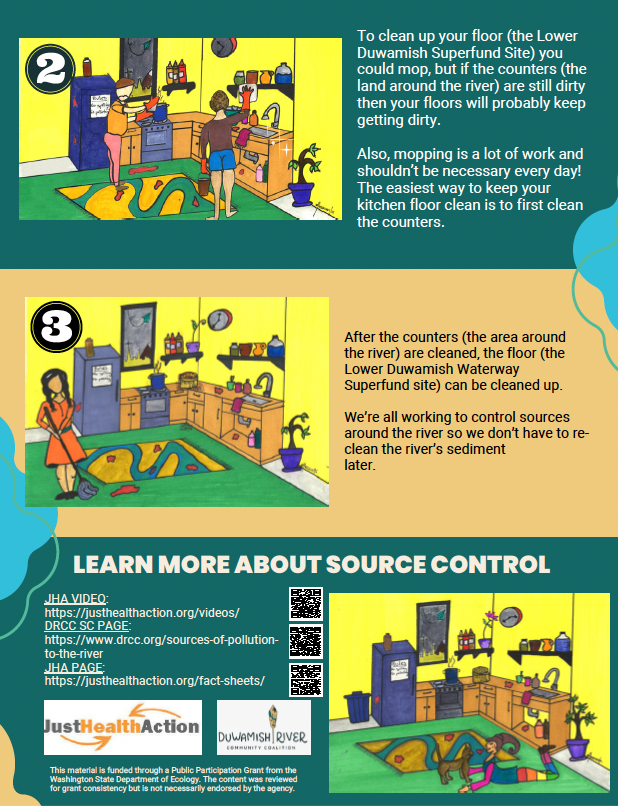Source Control =
Controlling Sources of Pollution
What is Source Control?
Source control is the process of finding sources of contamination, then stopping or reducing them before they reach the Lower Duwamish Waterway (LDW). We must ensure that sources of contamination to the LDW are sufficiently controlled before in-waterway cleanup begins. This means we must investigate more than 20,000 acres of land that drains into the river.
Source control includes a variety of actions, such as site investigation and cleanup, business inspections, controlling stormwater runoff and combined sewer overflows, coordination among agencies, and education. Find out how YOU can help keep stormwater clean.
Watch videos about source control in English, Spanish, Khmer, and Vietnamese!
King County created a story map that explains what source control is and what work has been done. More information can be found below!
How does pollution get into the river?
Contaminants in the soil and groundwater in the area around the river can find their way into the sediments through storm runoff and other routes (as shown below). The sediments contain a wide range of contaminants due to decades of industrial activity and runoff from urban areas.
Ecology has defined 24 source control areas. View the Source Control Area Map to read more about the work we've done in these areas.
The short-term goal is to control sources sufficiently to allow in‑waterway cleanup to begin. The long-term goal is to minimize recontamination of the river sediment and restore water quality in the river. However, finding and controlling sources is difficult in an urban environment. Even with aggressive source control, some recontamination will likely occur.
Model Toxics Control Act (MTCA) and Public Comment
The Model Toxics Control Act (MTCA) is Washington's hazardous pollution cleanup law (WA State “Superfund”). MTCA funds and directs the investigation, cleanup, and prevention of sites that are contaminated by hazardous substances. MTCA works to protect people’s health and the environment and to preserve natural resources for the future.
The Washington State Department of Ecology (Ecology) encourages community feedback via public comment periods during several parts of the cleanup of a polluted site.
Source Control Work Group
Ecology leads the interagency Source Control Work Group. Much coordination is needed between agencies to control sources of pollution within the 24 source control areas. This group of regulatory professionals meets monthly to share information, discuss strategy, develop action plans, implement source control measures, and track progress.
The Source Control Work Group includes:
Ecology: Lead for source control at properties that discharge directly to the waterway, as well as at upland contaminated properties.
City of Seattle: Lead for source control within their storm drain system.
King County: Lead for source control for discharges to wastewater or combined wastewater and stormwater systems.
EPA: Provides technical assistance, source control coordination with EPA sediment investigation and cleanup activities.
Upstream to downstream approach
We've determined that the most efficient way to manage site cleanups for source control is an upstream to downstream approach. This reduces the problem of contamination from an upstream site moving into a downstream site that has already been cleaned up.
The 24 source control areas are grouped into upper, middle, and lower reaches. The river flows northward, so the upper reach (upstream) starts in Tukwila, and the lower reach (downstream) ends at the southern tip of Harbor Island.
While we will prioritize site cleanups in the upper reach, we will continue to move forward with our work in the middle and lower reaches.
What is the Role of Washington Department of Ecology ECY ?
Ecology is leading the effort to clean up sources of contamination from the upland area surrounding the Lower Duwamish Waterway (LDW) Superfund Site. This is called ‘source control’. We define source control as finding the sources of contamination and taking actions to stop or reduce them before they reach the LDW. It’s a crucial part of our commitment to control contamination sufficiently so that the Environmental Protection Agency (EPA) can start cleanup of the river sediments. Our long-term goal is to minimize recontamination of the river sediment and restore water quality in the river. A variety of actions, such as business inspections, controlling stormwater runoff, education, and cleanup up of contaminated sites, are all part of source control. Contaminants in soil and groundwater in upland areas around the LDW pose a risk to human health and the environment. They can find their way into the river through groundwater discharges, storm runoff, erosion, and other pathways.
Upstream to downstream Ecology and EPA developed an “upstream to downstream” approach to source control and site cleanup. They divide the LDW into three sections called the Upper, Middle, and Lower Reaches. Since the river flows northward to Elliott Bay, the Upper Reach (upstream) starts in Tukwila and the Lower Reach (downstream) ends at the southern tip of Harbor Island. Cleaning up upstream sections first ensures that sediment moving downstream will be cleaner. Cleanup Oversight. They actively oversee the cleanup of 24 sites through a legal agreement cleanup process under the State Model Toxics Control Act (MTCA). The Toxics Cleanup Program currently oversees 20 cleanup sites and our Hazardous Waste and Toxics Reduction Program oversees 4 sites. Other sites are cleaned up independently through the Ecology Voluntary Cleanup Program (VCP), or through federal programs overseen by EPA.
Juntos si Podemos Cuidar a Nuestro Rio Duwamish
Juntos si podemos cuidar a nuestro rio Duwamish is a group of young visionaries working with leaders in our community to take care of our River Duwamish and the place we all call home.
We’re getting informed. We’re talking to experts. Mostly importantly, we’re making the information available to you in fun and short videos here on this page.
Join us in our journey by Liking this page.
Ecology's Toxic Cleanup Program manages 16 formal cleanup sites in the LDW source control area. Our Hazardous Waste and Toxics Reduction program manages five other sites, and our Voluntary Cleanup Program manages many more. EPA manages five upland sites as well as the in-waterway cleanup under the federal Superfund program. For more information click HERE










